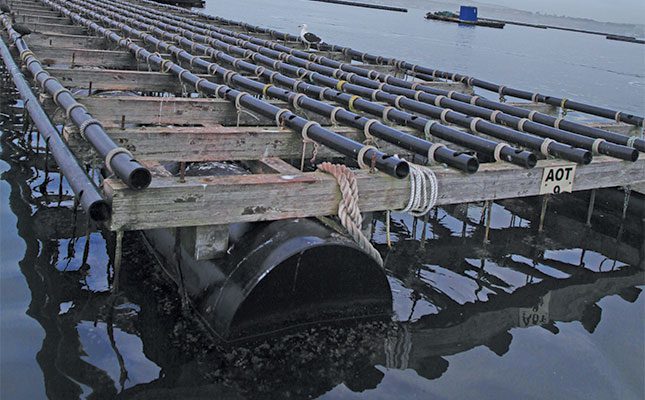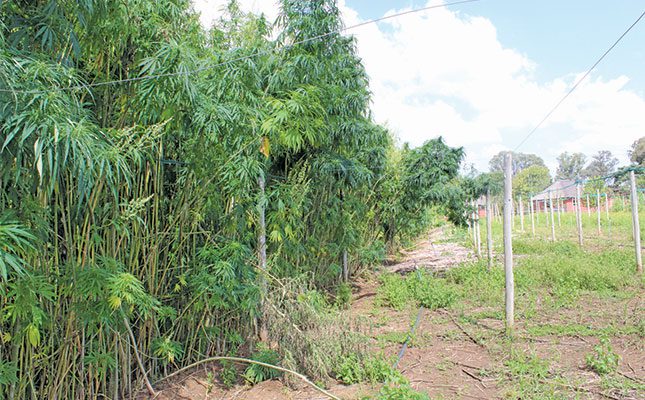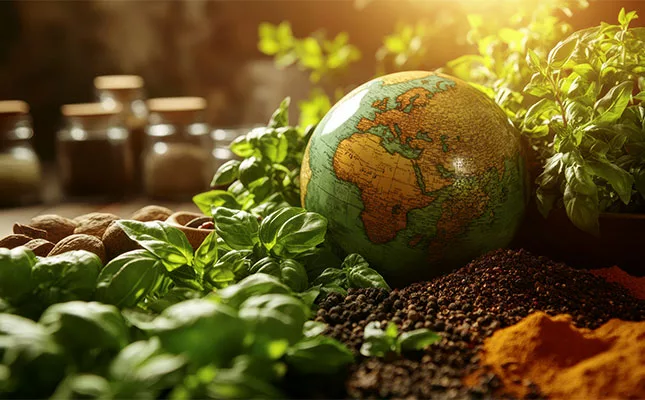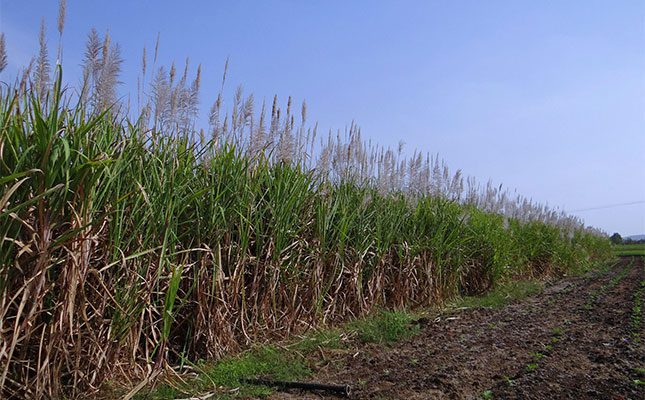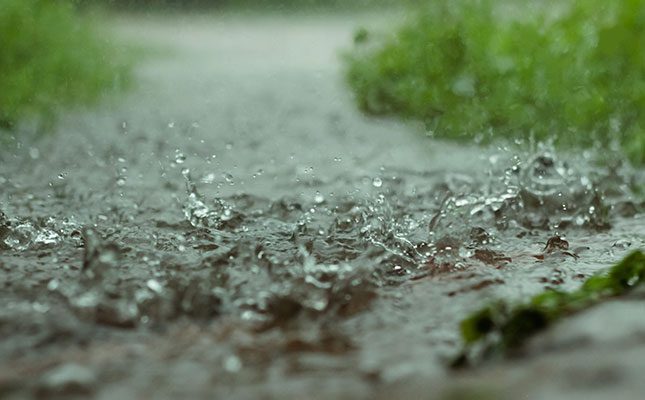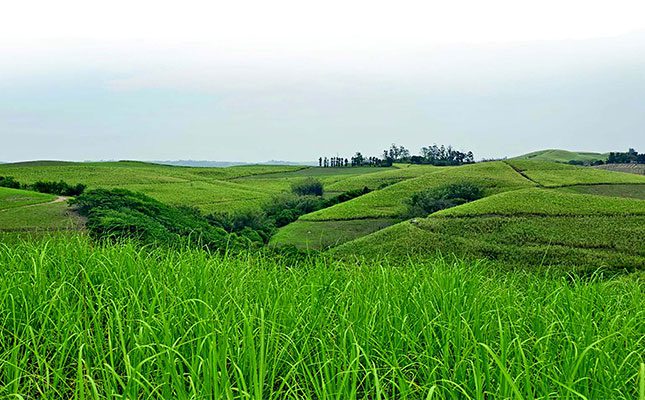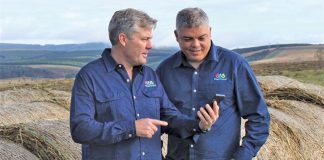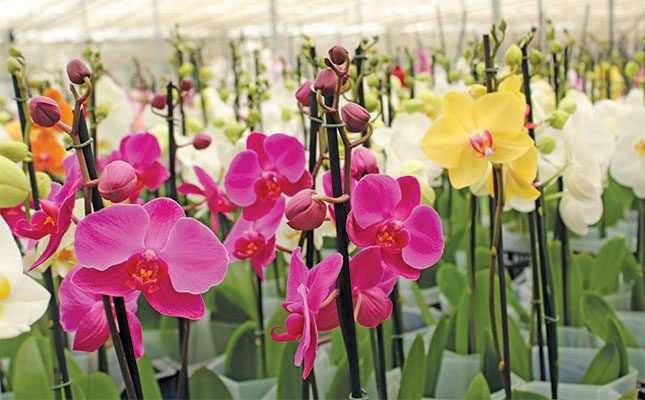
Photo: Lindi Botha
Orchids are an unforgiving crop; they will not tolerate an unfavourable climate, and require their exact needs to be met to grow and produce blooms.
“Orchid production is all about stability and consistency. They need even temperatures, humidity, and just enough light,” says Jaco Meershoek, production manager at LVG Plants in Krugersdorp, Gauteng.

LVG produces 1,2 million Phalaenopsis orchids per year. They also produce other flowering pot plants, bonsais, and a variety of foliage plants, all in fully computerised and automated greenhouses spanning 110 000m². These are labour-intensive processes, and the company employs 250 people.
The farm was started in 1985 by the Van Geest family, who emigrated to South Africa from the Netherlands. Market growth for orchids has been consistently positive since the family added this species to their range 35 years ago.
“Whereas cut flowers struggled to claw back market share post-COVID-19, orchid demand has been increasing by between 10% and 15% each year since 2020,” says Ivo-Jan van Geest, LVG’s commercial director. “[Orchids] last longer than cut flowers, which makes [them] a more popular option for consumers looking for value for money.”
The fastidious nature of orchids means that inputs need to be precise and consistent. The process starts with importing plant material from horticulture specialists Anthura, based in the Netherlands.
“They have the technology to produce high-quality plants, to our exact specifications, to meet the requirements from our market,” explains Bart van Geest, production director at LVG.
Plants imported by ship
The plants arrive by ship, in temperature-regulated containers. At this stage they are already six months old, and will spend another year growing in LVG’s greenhouses before they are ready for the market. This puts the time it takes to get this singular plant from emergence to market at 18 months – the same as beef cattle.
Once at LVG, the orchids go through three different production stages, each requiring its own unique climate and greenhouse. The first stage requires warmer temperatures to stimulate root and leaf development.
In the second phase, the greenhouse must be cooler to promote the formation of stems. In the third phase, temperatures must be increased once more for optimal flowering. It is important that the temperatures remain at the same levels in each stage 24 hours a day.
The plants arrive in South Africa in plugs containing sphagnum peat moss. This plug is then inserted into a plastic container containing a bark medium. The orchid will remain in this container for the duration of its life, minimising plastic waste and handling.
Meershoek says that one of the biggest challenges in producing orchids is managing handling of the plant.
“The leaves bend easily, and once they get a kink, it leaves a brown mark, which consumers don’t want. We therefore have roller belts to transport the crates of orchids in their containers from one phase to the next, so that they don’t have to be carried.”

The bark is also imported from the Netherlands. Meershoek explains that the orchids’ sensitivity means that the bark must be of a very specific quality.
“The pH can’t differ by a fraction from what the plant requires. We could not find this kind of consistency in product in South Africa and therefore must import it.”
LVG’s high-tech greenhouses are mostly temperature regulated through artificial intelligence (AI). Mini weather stations are placed throughout the greenhouses to measure temperature, light and humidity. The system is programmed according to the needs of the growth stage and will adjust these elements accordingly.
“If it is cloudy and there is not enough light in the greenhouse, the roof will automatically open to allow more light. If humidity is not sufficient, the misters will be switched on,” Meershoek explains.
Technology, however, is not foolproof, and spot checks are done with handheld meters to ensure the climate is what it should be. Irrigation must especially be more closely monitored.
Meershoek notes that the AI system is inclined to either over- or under-irrigate, which necessitates manual prompts of the irrigation system. Overhead and drip irrigation is used to achieve high levels of humidity, required to be between 12g/m3 and 16g/m3.
Irrigation frequency is determined by the plant size, varying between once every five days and once a week.
The plants are irrigated using rainwater, which has been collected in dams on the farms. The greenhouse roofs channel the water to the dam, providing a clean and ample source for irrigation.
Fertiliser recipes are specific to each growing phase. Respective elements are bought separately and mixed on the farm to deliver the exact requirements through the irrigation system. Since orchids are air plants – found growing in trees in the wild, not in soil – their fertiliser requirements are low.
“Orchids don’t want their roots covered. They want air and light. If you get the climate right, they don’t need much else,” says Meershoek.
Light and heat
South Africa has ample natural light for orchid production, so energy-intensive lighting systems are not required as they would be in the Northern Hemisphere. But with high summer and low winter temperatures, cooling and heating are required to provide the orchids with their exact requirements for production.
The roofs of the greenhouses are painted in summer to block high radiation. “It can reach up to 37°C here in summer, which pushes the greenhouse temperature up to 50°C. In addition to blocking radiation, misting and evaporative cooling systems help to keep the temperatures in check,” says Meershoek.
Pipe heaters are used to heat the greenhouses in winter. These run below the stands on which the plants are placed to provide heat to the roots of the plants. A boiler is used to heat the water that runs through these pipes. A significant investment in solar power is being made to reduce the use of coal for this heating system.
“Solar panels have been erected on just about every open space on the farm. We have two batteries to store energy. The whole system provides 1MW of power, which means we can rely solely on solar power for heating in the summer, and around 70% of the winter heating,” Meershoek explains.
The water in the boiler is a closed system, recirculating the same water and not requiring additional input.
The farm does however still rely on Eskom to power the rest of its operations. But an investment in variable speed drives (VSDs) for the greenhouses’ fans has significantly reduced this requirement, from around 500kWh to a maximum requirement of 310kWh.
“The VSD allows the fan systems to start up slowly, gradually increasing speed. This requires far less electricity than having a fan that needs to go full blast as soon as it is switched on. VSDs aren’t new technology, but they have become significantly more affordable in recent years. It was previously also a very bulky system that took up a lot of space. With the lower prices and smaller systems available now, it has made investment more feasible,” says Meershoek.
Pest management
Around 60% of the orchids produced by LVG are destined for Woolworths. The business is part of Woolworths’s Farming for the Future programme, which works with producers to achieve greater levels of environmental sustainability. Biological pest control is a chief focus, thereby reducing the use of chemical pesticides.
LVG started implementing biocontrol eight years ago as part of an integrated pest management system, switching to 100% biocontrol two years ago. It has not been an easy journey, since availability and efficacy of products on the market when they first started using biocontrol was low.
“Many products back then had temperature limitations, which meant we couldn’t use them since the greenhouses were often too hot for them to survive. But over the years the range of products have increased, as well as their ability to withstand a range of climates,” explains Meershoek.
LVG conducts their own trials before introducing new biocontrols. These results are collated with those done by the Woolworths research team, who then disperses the information to the Farming for the Future growers. This allows for a wider spread of knowledge, aiding all the growers in their journey towards full biocontrol.
Bark mite is one of the biggest pests attacking orchids. Since the mites are the same colour as the bark, they are difficult to spot by the pest scouts who check the greenhouses every morning. Slices of raw potato are therefore placed sporadically in the orchid containers, as they attract the mites.
“It’s easier to spot the brown mites on the white potatoes. There will always be a few mites here and there, but if numbers increase beyond a certain point, we know we have to bring in a [form of] biocontrol, like crypto-mites. Having crypto-mites permanently in the greenhouses is not feasible since they won’t have food if bark mites levels are low,” Meershoek explains.
Sticky traps are placed in the greenhouses to monitor pest levels. Thrips are especially attracted to the yellow sticky traps, making it easier to monitor these levels.

“Our scouts are constantly checking infestation levels. If the numbers go beyond a certain threshold, it becomes difficult to control them biologically.”
Meershoek uses neem oil to control thrips. Beneficial nematodes are used to control pests that lay their eggs in the soil. In total, he has an arsenal of 19 different biological products with which to fight pests.
Biocontrol requires a greater level of management, since pest species require individual solutions, unlike the blanket protection generally offered by chemicals. But this too is changing, and Meershoek notes that biological products that provide control for a range of pests are becoming more common.
“The level of control we can achieve with biologicals has improved massively over the years. Initially, biocontrol was more expensive because the industry was small and the supply chain underdeveloped. But now some of the biologicals are cheaper than their chemical counterparts.”
Another benefit of using biocontrol is that Meershoek does not struggle to control pests that have become resistant to chemical pesticides.
“We still alternate biocontrols where we can, just to be safe. The industry is still new and although there might not be resistance now, we don’t know if this is something that will develop in the future.”
Creating demand
Orchids are a product aimed at higher-end consumers, and its market potential is therefore limited in South Africa. The way in which orchids have been marketed has however played a role in their popularity, creating room for more growth.
Ivo-Jan believes Woolworths has played a role in the growth in demand for orchids.
“The way the flowers are presented in store, packaged and promoted, has made consumers more aware of orchids. The ever-changing array of colours we are able to provide means there is always something new to pique interest.”
LVG has around 20 different colours on offer, with specific colours made available for special occasions like Mother’s Day and Valentine’s Day.
Ivo-Jan notes that Woolworths’ sales have pointed to colour preferences for specific areas.
“Customers in Cape Town, for example, prefer white orchids, while pink orchids have higher sales in Knysna. The Woolworths market wants aesthetics that are light, clean, and natural. Packaging must also be sustainable. It is a market that appreciates simplicity, but also wants a high-quality, special product. Orchids tick all these boxes.”
For more information phone LVG Plants on 011 662 1428.




